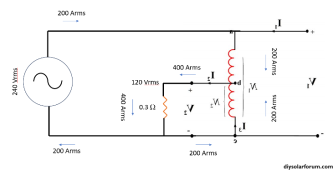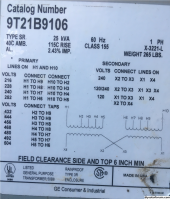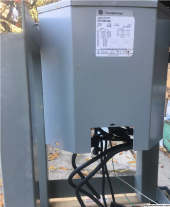@Hedges would you be so kind as to draw a simple diagram of what you mean and where the double-neutral current is flowing? I am picturing what you are saying in my head, but, I'm coming up with different numbers than you are.
Last edited:
@Hedges would you be so kind as to draw a simple diagram of what you mean and where the double-neutral current is flowing? I am picturing what you are saying in my head, but, I'm coming up with different numbers than you are.
If your neighbor can have a 400 amp 120vac load, what happens if you have one at your house?If you are feeding the utilities transformer with a 240 volt 200 amp backfeed all that power will still flow on L1 and L2. You could feed this back to the utility even if you did not have a neutral wire. The neutral is only needed for 120 volt circuits. It's 48,000 watts. The reason is that the current on each leg is 180 degrees out of phase with the other leg. That is why it cancels out. If the current was on the same phase then indeed the 200 amps would add together on the neutral, but that's not how 240 volt current works.
Now if a neighbor were to consume all that power you push into the transformer on a single 120 volt phase, they could draw 400 amps out of the transformer. It would flow out through one of the hot legs and back through the neutral. The transformer is then working essentially as a step down transformer. Half the voltage means twice the current since the power is conserved. 200 * 240 = 400 * 120. But again that 400 amps is not going to flow on the neutral wire going into your house. Your neighbor would need to have a 400 amp service and consume all that power on a single leg in order to get 400 amps on his neutral wire. So 24 * 2000 watt hair driers all on the same Hot Leg would do the job. If your neighbor plugged 12 hair driers into each leg, then he would also have 0 current on the neutral.
You are correct when you say the current on the neutral is the IMBALANCE. When you push a 240 volt source back to the grid, you have zero imbalance. Your neutral will have zero current.
If you are feeding the utilities transformer with a 240 volt 200 amp backfeed all that power will still flow on L1 and L2. You could feed this back to the utility even if you did not have a neutral wire. The neutral is only needed for 120 volt circuits. It's 48,000 watts. The reason is that the current on each leg is 180 degrees out of phase with the other leg. That is why it cancels out. If the current was on the same phase then indeed the 200 amps would add together on the neutral, but that's not how 240 volt current works.
Wait a second, that is true for a traditional autotransformer, but the utility transformer acts as a balanced auto-transformer. There is no current flowing on the primary side if total load matches total generation on the secondary. The utility isn't acting as a buck/boost transformer to derrive a neutral.If we consumers only draw power from the grid, utility transformer is an isolation transformer. But if we backfeed power while anyone draws single-phase load, we use it as an auto-transformer (plus isolation for any power flowing to or from primary side.)
If you are feeding the utilities transformer with a 240 volt 200 amp backfeed all that power will still flow on L1 and L2. You could feed this back to the utility even if you did not have a neutral wire. The neutral is only needed for 120 volt circuits. It's 48,000 watts. The reason is that the current on each leg is 180 degrees out of phase with the other leg. That is why it cancels out. If the current was on the same phase then indeed the 200 amps would add together on the neutral, but that's not how 240 volt current works.
Now if a neighbor were to consume all that power you push into the transformer on a single 120 volt phase, they could draw 400 amps out of the transformer. It would flow out through one of the hot legs and back through the neutral. The transformer is then working essentially as a step down transformer. Half the voltage means twice the current since the power is conserved. 200 * 240 = 400 * 120. But again that 400 amps is not going to flow on the neutral wire going into your house. Your neighbor would need to have a 400 amp service and consume all that power on a single leg in order to get 400 amps on his neutral wire. So 24 * 2000 watt hair driers all on the same Hot Leg would do the job. If your neighbor plugged 12 hair driers into each leg, then he would also have 0 current on the neutral.
You are correct when you say the current on the neutral is the IMBALANCE. When you push a 240 volt source back to the grid, you have zero imbalance. Your neutral will have zero current.
@Hedges would you be so kind as to draw a simple diagram of what you mean and where the double-neutral current is flowing? I am picturing what you are saying in my head, but, I'm coming up with different numbers than you are.

Yes, a million times easier. I understand now!Seeing the schematic with your eyes makes it so much easier:
Is this allowance restricted to main service panel upgrades because of PV/NEM installs only? I recently upgraded my panel from 100a to 200a service and want to know if I can qualify for this allowance???Overhead Upgrade:
View attachment 172180
"You may be eligible to deduct a $1,918 allowance from the total cost of your electric service if you are upgrading your panel."


I think you are mixing issues there; what you are describing is actually phase current being half of the imbalance or half of the winding seeing the full imbalance. The neutral currents still cancel to the extent they are balanced.The key is that current will only flow in one winding of the transformer if there is current flowing opposite direction in other winding.
Apply a load to the neutral, then current is allowed to flow in the directions shown.
Is this allowance restricted to main service panel upgrades because of PV/NEM installs only? I recently upgraded my panel from 100a to 200a service and want to know if I can qualify for this allowance???
I think you are mixing issues there; what you are describing is actually phase current being half of the imbalance or half of the winding seeing the full imbalance. The neutral currents still cancel to the extent they are balanced.
Is it done and billed yet?
I think it is available so long as amperage is upgraded.
Probably based on the idea that there will be increased load and revenue.
I understand the inverter output from the inverter is balanced at 240 volts, but if there is an imbalance on the 120 volt circuits in the panel or sub panel that will translate to an export of an imbalance and some current on the neutral. Do I have this right?If the current was on the same phase then indeed the 200 amps would add together on the neutral, but that's not how 240 volt current works.
............
You are correct when you say the current on the neutral is the IMBALANCE. When you push a 240 volt source back to the grid, you have zero imbalance. Your neutral will have zero current.
The current on one leg will be consumed locally instead of sent out. The current on N will be magically generated by the utility transformer. So the secondary is loaded with some work, though I’m not sure how much this work compares with just exporting it to the primary.I understand the inverter output from the inverter is balanced at 240 volts, but if there is an imbalance on the 120 volt circuits in the panel or sub panel that will translate to an export of an imbalance and some current on the neutral. Do I have this right?
Maybe I did not explain the scenario or I do not understand the concept. Lets try this hypothetical. A balanced generation output from the Inverter of 20 Amps. At the sub panel there is a 10 Amp load on L1 and a 5 Amp load on L2. The net export is 5 Amps but it is only on L2 because the L1 load and generation offset each other. Is my hypothetical correct? If not, why? Maybe I should use kWs in the example because that is how it is billed? I could think up a similar hypothetical in kWs or kWhs to show the imbalance, but I don't see that making a difference because the meter presumably converts Volts and Amps to kWs. I also realize much of this imbalance could be offset by other homes sharing that transformer.The current on one leg will be consumed locally instead of sent out.


